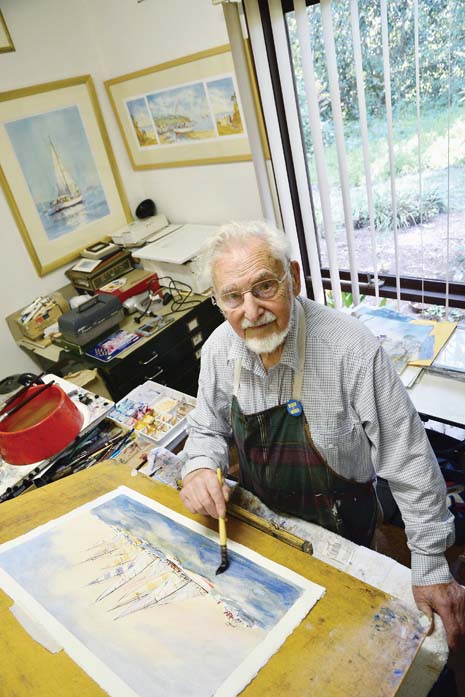
IT was 11 or 12 years ago that Ron Farnill was told he could expect to live “about another two and a half years”.
Not one to give up on enjoying life so easily, Farnill decided to “paint, instead of spending time cutting grass or fixing up the house”.
While still painting daily, he’s also spending time choosing 100 or so paintings for his upcoming exhibition, Sky, sea, sail and other things (93 years in the making).
The exhibition at Oak Hill Gallery, Mornington is also a lead-in to his 93rd birthday.
“People have talked about the need for me to have a retrospective, but for me it also has a lot to do with getting rid of some paintings,” Farnill says while looking around the lounge in his Red Hill house, which only has two chairs not stacked with framed paintings.
His watercolour scenes seem vaguely familiar, but he insists they’re “all made up – they’re local scenes, but I make up everything”. Paintings of boats at sea “could be anywhere”.
“Painting every day keeps old age away,” Farnill says, quickly adding that, for him, it is a meditation that can last hours without him realising the time.
He also runs art classes (limited to six students) where he’s often “confronted by peoples’ problems, which they expect you to be able to fix”. The “problems”, he explains, are to do with their art efforts, not their lives.
Born in Leeds, England in 1927, Farnill first won a prize for is art when he was a schoolboy.
But art wasn’t a viable career choice, so he “drifted” into the Royal Navy and became a mechanic with the fleet air arm and was on his way to the Pacific when World War II ended.
Without returning to Britain, his ship was directed to head for Ceylon (now Sri Lanka) “to keep the peace”.
On finding himself back in the UK 12 months’ later, Farnill completed his electrician’s apprenticeship, as well as taking up cycling.
He and his brother then bought tickets to Australia, setting off a series of “strange coincidences” that led to his meeting, and later marrying, his wife Betty.
Betty was returning home to Australia after a year-long cycling tour of Europe.
They hit it off, but Farnill and his brother were booked to disembark in Sydney, so goodbyes were made when the ship berthed in Melbourne.
However, the ship broke down and Farnill, with a few days up his sleeve and “looking for a hill”, rode a bike to the Dandenong Ranges. On his way back he noticed Heidelberg Road, where Betty lived, and paid her a visit.
“You think you have control, but big things in life seem to just happen,” he says.
The romance blossomed and Betty, a nurse, became Mrs Farnill after he returned from Sydney in 1953.
Farnill worked for the State Electricity Commission of Victoria before retiring at 49, after “suffering great stress” due to his workload.
At about the same time he again picked up his brushes, thanks to then Prime Minister Gough Whitlam offering free courses to older students at Frankston Technical School.
“We were sort of hippies, with an idea we could be self-sufficient,” Farnill says, listing the animals (goats, chickens and ducks) and vegetables they grew on their secluded acreage at Red Hill.
They discovered “you really need money”, so Betty continued nursing and he did part time electrical work.
Life was good, but Betty eventually underwent about 20 operations over 20 years for brain tumours. She died six years ago.
During their time together they bought a former Sydney to Hobart yacht, the 10-metre fibreglass Brumby. They sailed frequently but their plans to live aboard were thwarted by Betty’s illness.
The Farnills also delivered yachts interstate and Ron now claims them to be “the only sailors to make an emergency gybe to miss the moon”.
They were sailing through an area where gas and oil drilling sites were capped and fitted with lights. Seeing a light appearing ahead they took action to avoid what they thought would be a solid obstacle, only to discover they had been dodging a rising moon as it appeared and disappeared on swells during a 40-knot blow.
These days Farnill is often submerged in his art. His “addiction”.
His series of flamenco dancers were painted while listening to the music they – had they been real – would have been dancing to.
“I lose any outside would problems. I actually get into the painting,” he says.
His reverie is a bit like the description he gives to his style of painting: “It’s an illusion. The detail is not really there. It’s only the odd strokes of the brush that touch the paper.”
Ron Farnill, Sky, sea, sail and other things (93 years in the making), 11am-4pm, 1-31 March, Oak Hill Gallery, 100 Mornington-Tyabb Road, Mornington, phone 5973 4299.
First published in the Mornington News – 25 February 2020



